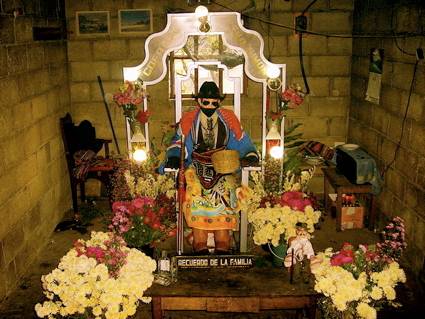Published in EntreMundos
November 2004
In the village of Santiago, on the shores of Lake Atitlan in the western highlands of Guatemala, I visited the folk-god Maximon. A wooden effigy with cowboy hat, sunglasses and grey silk tie, he sits behind a bank of candles and flowers, receiving gifts of cigarettes and coins. People talk to him patiently, intimately, as a friend, lifting his hands or touching him in the place his heart would be. They put cigarettes in his mouth and stand close to knock the ash away; I saw one girl rub the ash into her sleek black hair with a sort of casual reverence. They tip him back in his chair to tip rum down his throat, wiping his black lips carefully after he has drank. They lift his hat from his head and wear it on their own, or pick up his walking stick to emphasise points in their entreaties. He is treated with absolute respect at all times, but there is none of the grovelling awe we have come to associate with religious idolatry in the West. He seems to be a friend more than a deity; an extremely powerful friend. The colours of the candles burning before him represent different aspects of his power: red for love, green for business, pink for health, black for vengeance, white for protection from sorcerers. But perhaps the most surprising thing about the shrine of Maximon is the presence of the two other idols – Jesus and the Virgin Mary – at the back of the room. These two are offered no cigarettes or rum.
The official line of the Catholic Church is, predictably, that paying tribute to Maximon is akin to devil worship and should be avoided. But in reality the two faiths seem to exist in the small towns and villages of the Guatemalan highlands surprisingly easily. For religion in Central America has, since the days of the Spanish Conquest, always been an amalgam of two different cultures. The conquistadors never completely succeeded in replacing the indigenous religion with their own, despite the determination of their assault. Often they succeeded only in changing the symbols around, such as the goddess figure for the Virgin Mary, or the ancient Mayan cruciform (representing the sacred ceiba tree) for the crucifix. Mayan religion also laid heavy emphasis on blood-letting ceremonies, in which the most suitable blood was considered the blood of kings; thus when the Catholics preached that the King of the Jews had spilled his blood for all mankind, the Maya could easily understand the symbolism. Maximon, too, is an amalgam of different symbolic figures, and the mixture is surprising and bizarre. For what the cigarette-smoking, rum-drinking figure in the cowboy hat represents is a combination of Mayan gods, the genocidal conquistador Pedro de Alvarado, and the biblical Judas.
At first it’s hard to understand what this paradoxical idol could possibly mean. How can these people simultaneously worship the gods of their ancestors, the murderous invader who attempted to wipe out their entire culture and religion, and the man who betrayed Jesus? I still don’t understand the reasons for this weird combination, but visiting Maximon has made me think a lot about the rationale behind religion in general.
In another town I sat in a Catholic church and watched an ancient, tiny Mayan lady go down on her knees before Christ and kiss the stone floor at his feet. At the time I could not understand how she could devote herself so utterly to the god of the foreigners who, for the past 500 years, have systematically oppressed and slaughtered her people. It seemed perverse and inexplicable. But after visiting Maximon, the combination of a bloodthirsty oppressor and a traitor, I think I understand the sentiment – if not the logic – for worshipping a symbol of pain. Real love is loving someone no matter how many times they hurt you. In human terms, no matter how many slaps or bruises; in terms of a culture, no matter how many butcheries, genocides, rapes. A society that has been through such grief can surely find much psychological relief in prostrating itself collectively before the ghastly, battered, blood-stained, tortured body of Christ; the manifestation of an even greater, a universal, suffering. And in the case of Maximon, merging the figure of a cultural nemesis with the gods that he tried to destroy is an effective way of assimilating him, paradoxically negating his malevolence through its idolisation and worship. Perhaps loving someone is the greatest power you can have over them; and the greatest release from the sins they have done you in the past.
So I gave Maximon three cigarettes and lit a thin red candle before him. He smoked the cigarettes down to the filter, and the candle burned to a waxy stump on the concrete floor. As I left, I crossed myself – something I could never see myself doing in a Catholic church – and an old campesino nodded at me on his way through the door. I noticed he was carrying the black candle of revenge in his right hand, and in his left, a small bunch of flowers.


